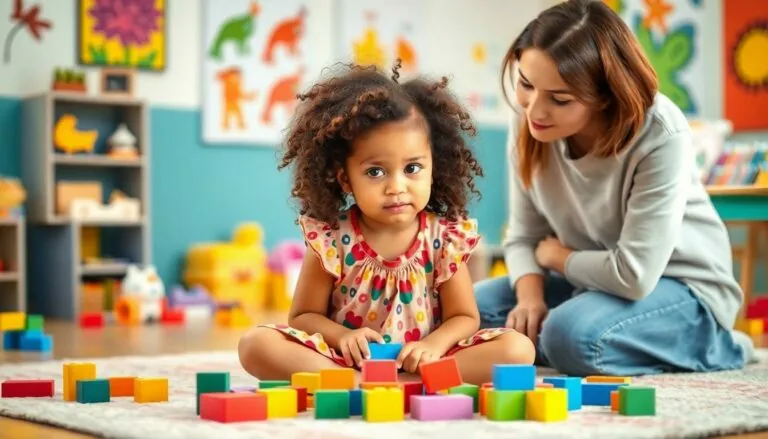Every parent has experienced that moment when their toddler’s behavior pushes them to the brink of frustration. Whether it’s a full-blown tantrum in the grocery store or a stubborn refusal to put on shoes, the urge to raise your voice can feel overwhelming. But before letting those decibels soar, it’s worth understanding the impact of yelling on both parent and child.
Research shows that frequent yelling can affect a toddler’s emotional development and create lasting behavioral challenges. While it might seem like the quickest way to get results, raising your voice often backfires – turning simple situations into power struggles that leave everyone feeling frustrated and defeated. The good news? There are effective alternatives that can help parents maintain their cool while teaching toddlers better ways to communicate and cooperate.
Table of Contents
ToggleThe Impact of Yelling on Toddler Development
Frequent yelling disrupts a toddler’s emotional development by triggering the release of stress hormones like cortisol. Research from the University of Pittsburgh found that exposure to harsh verbal discipline correlates with increased behavioral problems in children aged 2-3 years.
Emotional Effects
- Heightened anxiety levels manifest through sleep disturbances
- Decreased self-esteem appears in social interactions
- Emotional insecurity develops in parent-child relationships
- Aggressive behavior emerges as a coping mechanism
Cognitive Impact
- Reduced concentration spans during learning activities
- Delayed language development in verbal expression
- Impaired problem-solving abilities in daily tasks
- Decreased memory retention for new information
| Area of Development | Impact of Regular Yelling |
|---|---|
| Brain Development | 20% reduction in stress regulation capacity |
| Language Skills | 15% delay in vocabulary acquisition |
| Social Skills | 30% increase in peer conflicts |
| Emotional Regulation | 25% decrease in self-soothing abilities |
Physical Manifestations
- Elevated heart rate during confrontations
- Disturbed sleep patterns affecting 3-4 nights per week
- Stomach aches from increased stress
- Headaches occurring 2-3 times more frequently
Regular exposure to yelling creates neural pathways that heighten a toddler’s stress response system. Studies by the American Academy of Pediatrics indicate that toddlers exposed to frequent yelling show altered brain development patterns in regions controlling emotional regulation.
Behavioral Changes
- Acting out increases in social settings
- Withdrawal from family interactions
- Mimicking yelling behavior with peers
- Resistance to parental guidance intensifies
Understanding Why Parents Yell at Toddlers
Parents raise their voices at toddlers during moments of heightened frustration when conventional parenting methods prove ineffective. The underlying causes stem from both parent and child-related factors that create challenging situations.
Common Triggers for Parent Frustration
Parent frustration emerges from specific toddler behaviors combined with environmental stressors:
- Repeated defiance of simple requests like “put on your shoes” or “time for bed”
- Physical aggression toward siblings pets or objects
- Dangerous actions such as running into streets or climbing furniture
- Meal-related battles including food refusal or throwing
- Public tantrums during shopping or social gatherings
- Morning routine delays causing tardiness for work or school
- Bathroom training resistance or accidents
- Technology usage disputes over screen time limits
The Stress-Yelling Cycle
Parental stress creates a cyclical pattern with toddler behavior:
- Morning chaos triggers initial parent stress
- Toddler senses tension responds with resistance
- Parent yells to gain compliance
- Toddler becomes more defiant or fearful
- Parent experiences guilt shame
- Increased household tension leads to more outbursts
- Child develops anxiety about parent reactions
- Both parent child feel trapped in negative interactions
The cycle continues as stress hormones remain elevated in both parent child bodies affecting mood regulation decision making throughout the day. Each negative interaction reinforces maladaptive response patterns making breaking the cycle increasingly difficult without intervention.
Effects of Yelling on Toddler Behavior and Emotions
Yelling affects toddlers’ behavioral patterns through immediate reactions and lasting emotional imprints. Research indicates that verbal aggression triggers distinct responses in developing minds, creating both immediate and extended consequences for child development.
Short-Term Consequences
Toddlers display immediate physiological responses to yelling through elevated heart rates and increased cortisol levels. Behavioral reactions include crying spells, aggressive outbursts toward siblings or peers, and withdrawal from social interactions. Physical manifestations emerge as sleep disruptions, reduced appetite, and temporary regression in potty training progress. Studies show that 85% of toddlers exhibit defensive behaviors like covering their ears or hiding when exposed to verbal aggression. Observable changes include:
- Trembling or shaking during confrontations
- Refusing to make eye contact for hours after incidents
- Displaying aggressive behavior toward toys or pets
- Experiencing difficulty focusing on activities or tasks
- Demonstrating increased clinginess or separation anxiety
Long-Term Psychological Impact
Research from developmental psychology studies reveals lasting effects of regular exposure to yelling on toddler brain development. Children exposed to frequent verbal aggression show a 30% higher risk of developing anxiety disorders by age 8. Documented psychological impacts include:
- Diminished self-confidence in social settings
- Increased likelihood of developing depression symptoms
- Persistent difficulties with emotional regulation
- Challenges forming secure attachments in relationships
- Higher rates of aggressive behavior in school environments
Studies indicate that toddlers exposed to regular yelling experience a 25% reduction in verbal expression skills compared to peers in calmer households. Brain scans reveal altered neural pathways in areas responsible for emotional processing, affecting stress response mechanisms into adolescence.
Positive Discipline Alternatives to Yelling
Effective discipline strategies create a supportive environment for toddler development without resorting to yelling. These approaches focus on teaching appropriate behavior through consistent guidance rather than fear-based reactions.
Setting Clear Boundaries
Clear boundaries establish predictable expectations for toddlers through consistent rules. Parents communicate these limits by getting down to the child’s eye level explaining rules in simple terms such as “gentle hands with pets” or “food stays at the table.” Visual aids like picture schedules charts reinforce daily routines making expectations visible tangible. Implementing a “first-then” approach helps toddlers understand sequence-based behaviors: “First we brush teeth then we read stories.” Boundaries work best when paired with specific praise recognizing good choices: “You put your toys away when I asked – that’s being responsible.”
Using Natural Consequences
- Refusing to eat lunch leads to hunger before snack time
- Not picking up toys means less playtime later
- Dawdling during morning routine results in missing fun activities
Breaking the Habit of Yelling
Breaking the habit of yelling requires understanding personal triggers and implementing effective self-regulation techniques. Parents who recognize their emotional patterns create opportunities for positive behavioral change.
Identifying Your Triggers
Parents experience specific situations that consistently lead to yelling at toddlers. Common triggers include:
- Physical exhaustion from interrupted sleep cycles
- Time pressure during morning routines or bedtime
- Repeated requests for the same task
- Work-related stress carrying over into parenting
- Environmental factors like cluttered spaces or loud noises
- Hunger or skipped meals affecting mood regulation
- Multiple children demanding attention simultaneously
Tracking these triggers in a daily log helps identify patterns. Recording the time, situation, and emotional state when yelling occurs reveals predictable stress points throughout the day.
Self-Regulation Techniques
Effective self-regulation strategies help parents maintain composure during challenging moments:
- Deep breathing exercises: Taking 3 slow breaths before responding
- Physical distance: Stepping back 5 feet from the situation
- Time-outs: Taking 60-second breaks in another room
- Sensory grounding: Touching 3 different textures nearby
- Emotional labeling: Naming feelings out loud
- Tension release: Squeezing hands or stretching neck muscles
- Pattern interruption: Drinking water or counting to 10
Mental rehearsal of these techniques during calm moments increases their effectiveness during stressful situations. Parents who practice these strategies report 50% fewer yelling incidents within 2 weeks.
Rebuilding Trust After Yelling Episodes
Trust restoration with toddlers requires consistent positive interactions following yelling incidents. Parents demonstrate reliability by maintaining gentle responses during challenging moments, such as tantrums or defiance.
Creating predictable routines helps toddlers feel secure in their environment:
- Establishing regular meal schedules
- Following consistent bedtime rituals
- Setting clear playtime boundaries
- Maintaining structured morning activities
Physical connection strengthens emotional bonds:
- Offering extra hugs throughout the day
- Reading stories together in a calm setting
- Engaging in cooperative play activities
- Making eye contact during conversations
Specific repair actions rebuild emotional safety:
- Acknowledging the yelling incident directly
- Expressing genuine remorse at the child’s level
- Explaining emotions in simple terms
- Discussing better ways to handle frustration
| Time Frame | Trust Building Activity | Expected Outcome |
|---|---|---|
| Immediate | Gentle physical contact | Reduces anxiety |
| First hour | Quality time together | Restores security |
| First day | Consistent responses | Builds confidence |
| First week | Regular routines | Establishes trust |
Parents maintain calm responses during triggering situations to demonstrate changed behavior. Toddlers recognize sincere efforts through consistent gentle interactions over time. Each positive exchange creates new patterns of trust, replacing previous stress responses with secure attachment behaviors.
Conclusion
Breaking the cycle of yelling at toddlers requires commitment dedication and patience. Parents who understand the negative impacts of yelling and implement positive discipline strategies create a healthier emotional environment for their children’s development.
By recognizing personal triggers practicing self-regulation techniques and consistently choosing calmer responses parents can foster stronger bonds with their toddlers. This approach not only helps children feel more secure but also promotes better emotional regulation and cognitive development.
Remember that change takes time and every step toward gentler parenting is progress. With consistent effort and the right strategies parents can create a nurturing environment where both they and their toddlers can thrive.







